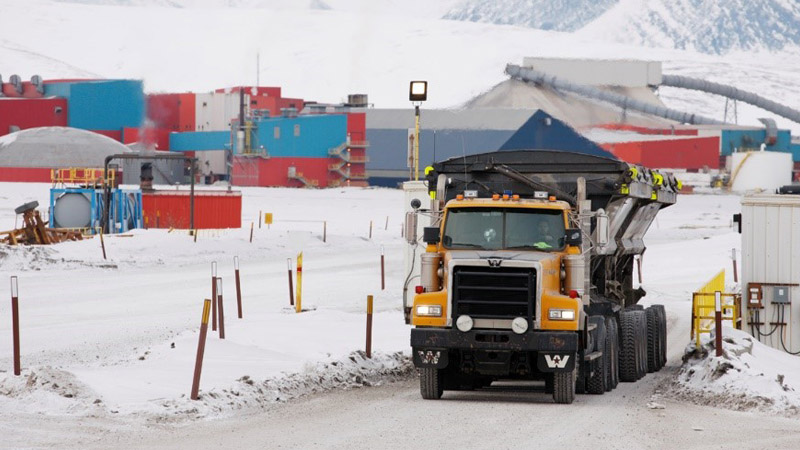Teck’s Red Dog Operation is situated in the sweeping tundra of northwest Alaska, a landscape with plentiful caribou, snowy owls and other wildlife. The region, sometimes referred to as a cold desert, is a land of long winters and short, cool summers. It’s with this backdrop that our Red Dog mine was started over 30 years ago in partnership with NANA, a Regional Alaska Native corporation owned by the Iñupiat people. The land and sea are integral to supporting the way of life and traditional subsistence needs of the Iñupiat people who call this region home.
Lead and zinc concentrate is mined and milled at Teck’s Red Dog Operations, then transported along the 52-mile DeLong Mountain Transportation System (DMTS) road before arriving at the Red Dog Port Site for shipping around the world. Concentrates are hauled year-round and kept in storage buildings at the port over the winter months. During the ice melt of summertime they are then loaded onto lightering barges that ferry the concentrate to cargo ships.
Managing Fugitive Dust
The process of mining and transportation can generate dust. As part of our commitment to environmental protection and to the health and safety of our employees and communities, we work to minimize the release of dust from our operations. Of particular concern for air quality is the impact of fugitive dust, the dust particles that become airborne and are carried by the wind. As part of Red Dog’s Fugitive Dust Management Program, numerous projects have been successfully implemented in the past two decades to reduce the impacts of fugitive dust at the mine site, haul road and at the port site.
This program aims to continually reduce fugitive dust and metals emissions, improve collaboration and communication regarding dust issues among all stakeholders, and conduct multiple levels of monitoring to better understand dust impacts and how they can be mitigated.
In 2020 and working under COVID-19 restrictions, the team at Red Dog worked on a number of projects and studies to continue improving dust management. These included:
- Completing a new fill station water source near the pit entrance, to allow greater effectiveness of the road watering truck.
- Completing project planning to replace a concentrate storage building’s roof at Red Dog’s port site and completing an engineering review of options to replace parts of the exterior shiploader conveyor enclosure system with more robust and durable structures.
- Evaluating and developing a protocol for delaying blasts during windy conditions.
This work builds on past efforts to reduce fugitive dust at Red Dog mine, along the haul road, and at the port. Since operations commenced in 1989, Red Dog has invested more than $25 million in operational and facility improvements geared towards reducing fugitive dust emissions. At the mine site, this work has included replacing a concentrate storage building roof, installation of a seasonal truck wash for haul trucks exiting the concentrate storage building as well as a seasonal in-pit truck wash. Dust suppressant is also applied annually on to tailings at the Red Dog tailings impoundment facility.
To reduce dust along the DMTS road, Red Dog procured a new haul truck fleet in the 2000s that eliminates potential for leakage during transport. Major projects to minimize dust impacts at the port include upgrading parts of the enclosed shiploader conveyor system, installing baghouses to actively collect dust, and installing an air wash to remove dust from trucks as they exit the Truck Unloading Building.
Finally, calcium chloride dust suppressant has been successful in minimizing dust at yards and roads throughout the operation. Additional dust suppressant products have been studied for use at the site but have not yet proven as effective as the calcium chloride.
To protect the marine environment and the people and wildlife that depend on it, an ongoing Marine Sediment Monitoring Program is in place at the Red Dog port site. Following improvements at the port site, metals concentrations from dust deposition at the Chukchi Sea port site have been low, and are generally within ranges measured in Chukchi Sea samples collected from areas unaffected by mining, a sign of the program’s success in protecting the sensitive marine ecosystem.
“Monitoring remains an essential part of the ongoing fugitive dust program, because the results are used to dictate best management practices that allow us to continually improve and adapt our management practices”, says Johanna Salatas, Environmental Coordinator at Red Dog Operations.
We continue to monitor and evaluate our performance and look for opportunities for further improvement. We are committed to protecting air quality through responsibly managing dust impacts, to ensure the local communities and ecosystems remain healthy and thriving well into the future.
Learn more about our approach to Air Quality on our website.


